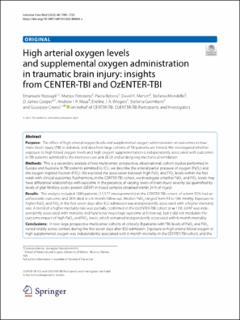| dc.description.abstract | Purpose The effect of high arterial oxygen levels and supplemental oxygen administration on outcomes in traumatic brain injury (TBI) is debated, and data from large cohorts of TBI patients are limited. We investigated whether exposure to high blood oxygen levels and high oxygen supplementation is independently associated with outcomes in TBI patients admitted to the intensive care unit (ICU) and undergoing mechanical ventilation. Methods This is a secondary analysis of two multicenter, prospective, observational, cohort studies performed in Europe and Australia. In TBI patients admitted to ICU, we describe the arterial partial pressure of oxygen (PaO2) and the oxygen inspired fraction (FiO2). We explored the association between high PaO2 and FiO2 levels within the first week with clinical outcomes. Furthermore, in the CENTER-TBI cohort, we investigate whether PaO2 and FiO2 levels may have differential relationships with outcome in the presence of varying levels of brain injury severity (as quantified by levels of glial fibrillary acidic protein (GFAP) in blood samples obtained within 24 h of injury). Results The analysis included 1084 patients (11,577 measurements) in the CENTER-TBI cohort, of whom 55% had an unfavorable outcome, and 26% died at a 6-month follow-up. Median PaO2 ranged from 93 to 166 mmHg. Exposure to higher PaO2 and FiO2 in the first seven days after ICU admission was independently associated with a higher mortality rate. A trend of a higher mortality rate was partially confirmed in the OzENTER-TBI cohort (n = 159). GFAP was independently associated with mortality and functional neurologic outcome at follow-up, but it did not modulate the outcome impact of high PaO2 and FiO2 levels, which remained independently associated with 6-month mortality. Conclusions In two large prospective multicenter cohorts of critically ill patients with TBI, levels of PaO2 and FiO2 varied widely across centers during the first seven days after ICU admission. Exposure to high arterial blood oxygen or high supplemental oxygen was independently associated with 6-month mortality in the CENTER-TBI cohort, and the severity of brain injury did not modulate this relationship. Due to the limited sample size, the findings were not wholly validated in the external OzENTER-TBI cohort. We cannot exclude the possibility that the worse outcomes associated with higher PaO2 were due to use of higher FiO2 in patients with more severe injury or physiological compromise. Further, these findings may not apply to patients in whom FiO2 and PaO2 are titrated to brain tissue oxygen monitoring (PbtO2) levels. However, at minimum, these findings support the need for caution with oxygen therapy in TBI, particularly since titration of supplemental oxygen is immediately applicable at the bedside. | en_US |

